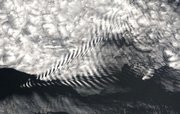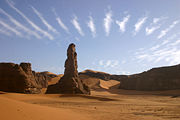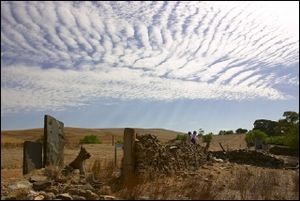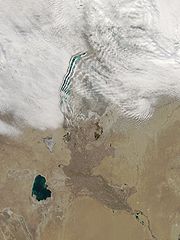
Wave cloud
Encyclopedia

Cloud
A cloud is a visible mass of liquid droplets or frozen crystals made of water and/or various chemicals suspended in the atmosphere above the surface of a planetary body. They are also known as aerosols. Clouds in Earth's atmosphere are studied in the cloud physics branch of meteorology...
form created by atmospheric internal wave
Internal wave
Internal waves are gravity waves that oscillate within, rather than on the surface of, a fluid medium. They are one of many types of wave motion in stratified fluids . A simple example is a wave propagating on the interface between two fluids of different densities, such as oil and water...
s.



Formation
The atmospheric internal waveInternal wave
Internal waves are gravity waves that oscillate within, rather than on the surface of, a fluid medium. They are one of many types of wave motion in stratified fluids . A simple example is a wave propagating on the interface between two fluids of different densities, such as oil and water...
s that form wave clouds are created as stable air flows over a raised land feature such as a mountain range
Mountain range
A mountain range is a single, large mass consisting of a succession of mountains or narrowly spaced mountain ridges, with or without peaks, closely related in position, direction, formation, and age; a component part of a mountain system or of a mountain chain...
, and can form either directly above or in the lee of the feature. As an air mass travels through the wave, it undergoes repeated uplift and descent. If there is enough moisture in the atmosphere, clouds will form at the cooled crests of these waves. In the descending part of the wave, those clouds will evaporate due to adiabatic
Adiabatic process
In thermodynamics, an adiabatic process or an isocaloric process is a thermodynamic process in which the net heat transfer to or from the working fluid is zero. Such a process can occur if the container of the system has thermally-insulated walls or the process happens in an extremely short time,...
heating, leading to the characteristic clouded and clear bands. The cloud base on the leeward side is higher than on the windward side, because precipitation on the windward side removes water from the air.
It is possible that simple convection
Convection
Convection is the movement of molecules within fluids and rheids. It cannot take place in solids, since neither bulk current flows nor significant diffusion can take place in solids....
from mountain summits can also form wave clouds. This occurs as the convection forces a wave or lenticular wave cloud into the more stable air above.
Climate Modeling
Wave clouds are typically mid- to upper-tropospheric ice clouds. They are relatively easy to study, because they are quite consistent. As a result, they are being analyzed to increase our understanding of how these upper-level ice clouds influence the Earth's radiation budget. Understanding this can improve climate models.Recreation
The streamlines in these clouds have the steepest slope a few kilometers downwind of the lee slope of a mountain. It is in these regions of highest vertical velocity that sailplanesGliding
Gliding is a recreational activity and competitive air sport in which pilots fly unpowered aircraft known as gliders or sailplanes using naturally occurring currents of rising air in the atmosphere to remain airborne. The word soaring is also used for the sport.Gliding as a sport began in the 1920s...
can reach record-breaking altitudes.
Structure
In an ideal model, a wave cloud consists of supercooled liquid water at the lower part, a mixed phase of frozen and liquid water near the ridge, and ice beginning slightly below the ridge and extending downstream. However, this doesn't always occur. Wave cloud structure ranges from smooth and simple, to jumbled phases occurring randomly. Often, ice crystals can be found downwind of the waves. Whether this happens depends on the saturation of the air. The composition of the ice is currently an active topic of study. The main mechanism for ice formation is homogeneous nucleationNucleation
Nucleation is the extremely localized budding of a distinct thermodynamic phase. Some examples of phases that may form by way of nucleation in liquids are gaseous bubbles, crystals or glassy regions. Creation of liquid droplets in saturated vapor is also characterized by nucleation...
. The ice crystals are mostly small spheroidal and irregular-shaped particles. Ice columns make up less than 1%, and plates are virtually nonexistent.
Multi-level mountain wave clouds form when the moisture in the air above the mountain is located in distinct layers, and vertical mixing is inhibited.

